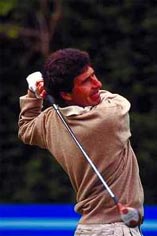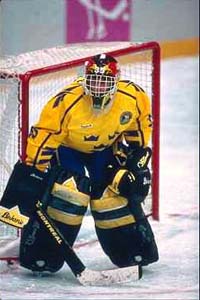Sports photography is fun and interesting. We're talking here about downhill skiing and snowboarding, though the tips for great downhill photos are true for cross country skiing as well.
Before you take a picture of someone on the slopes, you should consider the answers to three questions:
- How should I handle the camera in these cold conditions?
- How can I capture a sharply focused image of the skier or snowboarder that gives the illusion of speed? Or a stop action photograph?
- How can I capture a well-exposed image?
Cold Conditions
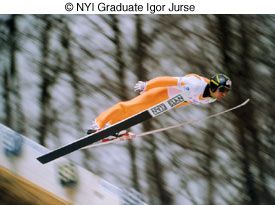
First, how should you handle your camera in cold conditions? Batteries often fail in the cold. Shutters become sluggish. We suggest you read our article on Cold Weather Photography Tips which includes winter photography tips and techniques for those venturing out with a camera in freezing conditions.
But in general, when it comes to skiing, the basic goal is to keep the camera and batteries warm when you're outside. How? We suggest you keep them inside your parka, close to the warmth of your body. Take them out only when you are ready to shoot.
Of course, keeping the camera inside your parka may be difficult if you're using a medium-format camera or even a large DSLR. Our photography tip: If you just want to capture a picture of your friend/spouse/child on skis, use a smaller camera. A point-and-shoot or even a single-use "cardboard" camera. If you want to take a truly professional picture, then use the best camera you can, and keep it as warm as you can until you shoot.
Sharp Focus
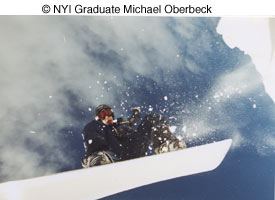
The second question is: How can you capture a sharply focused image that gives the illusion of speed?
Timing...timing...timing. The starting point is to know where to position yourself so that you'll be in the right location when the skier-subject flashes by. What's needed here is communication. We don't mean that you need walkie-talkies. Rather, before you set up for the shot, talk to the skier and agree on exactly where you will set up, decide where the skier will pass you, and — most important — agree on a signal from you to indicate when the skier should start.
This last sports photography point is important: If you don't agree on some sort of signal, dollars to doughnuts the skier will fly past you before you're ready. Make sure the skier is aware of how long it will take for you to set up: You have to ski down to the agreed-upon location, set your poles, take off your gloves, get out the camera, get it ready, and set yourself and the camera for the shot. Only then are you ready!
Our suggestion: Tell the skier not to budge until you give the signal — for example, until you wave your arms over your head. Don't rely on a verbal signal, like shouting "Ready!" The skier probably won't hear you. And don't rely on any sort of subtle visual signal, like pointing a finger. The skier probably won't see it. Agree on a large, unambiguous arm movement!
Another sports photography point here: Notice that we said you would take off your gloves. We're assuming that you're skiing too and that you are wearing klutzy ski gloves. You can't easily handle a camera with these gloves on. So, cold as it may be, you're going to have to take off your gloves to take the picture. You may want to consider carrying an extra set of gloves with fingertips that can be folded back so that you can manipulate the camera controls. Backpacking stores generally sell gloves like these.
Now, where should you set up? In part, this depends upon the type of picture you're going to take to produce the illusion of speed.
How to Use Your Camera — Stopping Motion
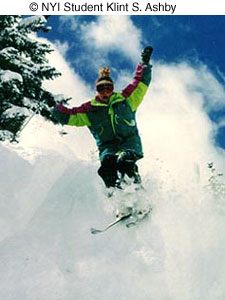
To get a head-on shot like the one shown here, you've practically got to set up in the skier's path. In this case, NYIP student/photographer Klint S. Ashby set up right below a big mogul that the skier and he had agreed would be the point at which the shot would be taken. As explained in the NYIP Complete Course in Professional Photography, you can use a slower shutter speed to "freeze" a subject moving toward you, even though the same slower speed wouldn't freeze a subject moving perpendicular to you. In this case, Klint obtained a sharp image of the skier by pre-focusing on the spot at which he expected to take the picture. In other words, Klint focused on the top of the mogul and waited till the skier reached that point.
Some of today's autofocus DSLR cameras can focus fast enough that you don't even have to prefocus. Just follow the skier in your viewfinder and shoot at any time — the autofocus will get the picture no matter when you shoot. That's one possibility.
There's one danger in using autofocus in a fast moving scene. If your subject isn't in the center of your viewfinder, your camera will still focus on whatever is in the center of the viewfinder. If that's a pine tree 75 feet behind your subject, then you may find that your intended subject is out of focus.
If you haven't read the tip "Sharp Focus, A Guide to Using Autofocus" make sure you do so. As you'll read, the trick to getting a well-focused photo of an off-center subject is to use focus lock. While it's a lot easier to use focus lock when your subject is standing still or moving slowly, by applying focus lock to a static part of the scene where your subject will be, you can overcome the tendency of autofocus to make automatic mistakes.
But be wary of another: "Some point-and-shoot cameras don't autofocus instantaneously. Instead, they delay for a moment after you press the shutter-release before actually taking the picture. If your camera has this sort of delay, watch out! You may press the button at the "critical moment" and the camera may record just an empty patch of snow by the time it responds. The message here: Know your camera!
By the way, we have a question about this picture: Where's his other pole?
Panning Motion
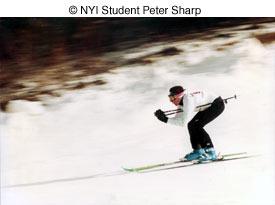
Now, here's another type of picture. Here NYIP student/photographer Peter Sharp panned with the skier to keep him sharp (no pun intended) in the picture. In this case, Peter set himself up so that the skier would move past him on the perpendicular. He might have tried to freeze the action by using a very fast shutter speed — say, 1/1000th of a second. But Peter had a better idea. If he had merely frozen the subject, he would have ended up with a picture in which nothing appeared to move. The skier would be frozen motionless. The trees would be frozen motionless too. And the entire picture would look static.
Peter applied what he had learned about sports photography in his very first NYIP Complete Course in Professional Photography lesson — he created the illusion of motion and speed by panning with the skier. The net effect is to capture the image of the skier in sharp focus against a blurred background. The key to good panning is twofold: First, use a slow shutter speed — say, 1/30th. Second, follow the subject in your viewfinder as he approaches you, keep him there as you shoot, and keep following him after you shoot. Your objective is a smooth motion like a golfer's or tennis-player's swing — starting with a backswing and continuing "through the ball" to a follow-through.
Frozen Motion
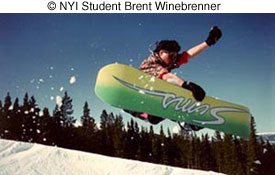
Now, here's an example of a picture by NYIP student Brent Winebrenner in which the motion is frozen.
Why does freezing the motion work here? Because of two factors.
One is the position of the snowboarder: He's in mid-air. Unless he knows how to levitate while standing still, he's flying through the air! That's the clear implication of this type of picture to any viewer. The second factor is the flying bits of snow.
They say "Action" to the viewer's eye! For these two reasons, freezing the action worked here. In general, freezing the action can work when the subject is in mid-air. The viewer thinks: People can't fly! This must be taken at the height of some action.
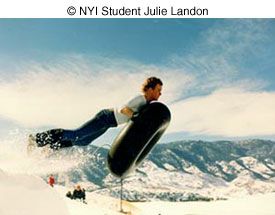
Here's another example, this time by NYIP student/photographer Julie Landon, where "freezing the action" works.
Exposure
All right. Question Three: How can you capture a well-exposed image of the skier? This is the real key to good skiing pictures. All too often you're shooting in extremely bright conditions. The snow is very bright. So is the sky. And your built-in meter interprets all this brightness to mean that you don't need much exposure. Result? Most pictures taken on the slopes are underexposed. Sure, the snow looks great. And so does the sky. But the skier who's your subject is all-too-often a dark silhouette!
Here's a perfect example of the problems you can face. How can the photographer — in this case, NYIP student/photographer Cliff Fulton — get proper exposure of the skier when his built-in meter is reading that bright sky?
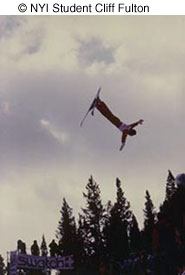
In a way, this returns us to the first of the three NYIP Guidelines. What's your subject? Your subject is the skier. Well, if your subject is the skier, then you want to expose for the skier, not for the snow. How can you get the right exposure? We offer a number of photography tips:
First, while you're talking together, take a closeup reading of the skier's face, and set your exposure accordingly. Use that exposure setting when you later take the shot.
Second, if you forgot to take that closeup reading — or you couldn't — take a "substitute reading" on your own skin. If your skin tone is approximately the same as the skier's, the setting you get should be close enough. Remember that you must make certain the area you read is in the same lighting and same angle relative to the light as your subject.
Third, you might take an incident reading with a light meter. The incident reading will read the light, not the subject matter. It should place the brightness of the snow, the sky, and the skier exactly where you want them.
Fourth, you could take a reflected reading of a gray card with your built-in meter or a separate meter. The result should be the same as you got with the incident reading.
Fifth, use fill flash. We advise this especially when you are trying to freeze a skier who is coming toward you. The light of the flash compensates for the brightness of the snow and sky behind the skier. On the other hand, realize the limitation of your flash unit. It probably has a range of ten to fifteen feet. Don't expect it to light up the mountain. Odd as it may sound, if you use a single-use camera, get one with a built-in flash and use it. As bright as your background is, the fill flash will help light your subject. Use it every time.
So here are five possibilities. The one thing we don't advise is to rely on your built-in meter and just "meter the scene."
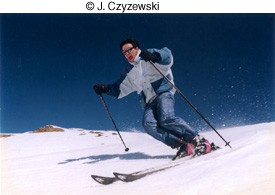
Digital cameras automatically white balance and therefore the snow in your images should correctly appear to be white. If they don't, check your camera's manual to find out how to manually white balance the scene.
By the way, in case you are not clear on how to take an incident reading or how to use a gray card, we have an article on our Web site that will help you.
Happy skiing!


